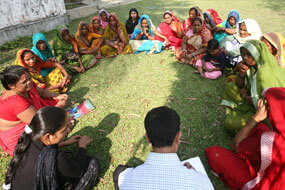Blogs
SOCIAL AUDITING:
 As a new, more democratic political era opens in Nepal, the demand for greater citizen participation and better governance is growing.
Government and civil society are pushing for more transparent and accountable government, and social accountability tools like social audits are being introduced. Over the past two years, the Department of Health Services (DOHS) has
begun implementing two different social audit approaches and guidelines. The first - linked to the Aama Programme (formerly the Safe Delivery Incentive Programme) - was developed by the Family Health Division of MoHP. The second, which
takes a broader look at health service provision, was developed by the Management Division. In order to harmonise social auditing in Nepal’s public health sector, the Primary Health Care Revitalisation Division led a review of the
different approaches being used in the health and social sectors, while drawing on experience from the South Asia region. Aided by this evidence-based review of practice and consultations with key stakeholders, DOHS plans to develop
a harmonised approach for subsequent piloting and scaling up.
As a new, more democratic political era opens in Nepal, the demand for greater citizen participation and better governance is growing.
Government and civil society are pushing for more transparent and accountable government, and social accountability tools like social audits are being introduced. Over the past two years, the Department of Health Services (DOHS) has
begun implementing two different social audit approaches and guidelines. The first - linked to the Aama Programme (formerly the Safe Delivery Incentive Programme) - was developed by the Family Health Division of MoHP. The second, which
takes a broader look at health service provision, was developed by the Management Division. In order to harmonise social auditing in Nepal’s public health sector, the Primary Health Care Revitalisation Division led a review of the
different approaches being used in the health and social sectors, while drawing on experience from the South Asia region. Aided by this evidence-based review of practice and consultations with key stakeholders, DOHS plans to develop
a harmonised approach for subsequent piloting and scaling up.
International good practice shows that social accountability tools such as social audits, community score cards, community monitoring, public audits and public hearings can impact on public service delivery, increasing efficiency and effectiveness. This can occur in many ways: by exposing corruption and absenteeism, increasing awareness of entitlements, empowering citizens-including women, poor and the excluded- to demand accountability and rights, and raising awareness of providers’ responsibilities.
Good practices that lead to developing a harmonised social audit approach in health include the following:
Some programmes have linked the social audit with a financial audit, which appears to have helped in timely completion of the social audit. Several areas of currently weak social audit practice to be addressed in the design of future models have also been identified:
 As a new, more democratic political era opens in Nepal, the demand for greater citizen participation and better governance is growing.
Government and civil society are pushing for more transparent and accountable government, and social accountability tools like social audits are being introduced. Over the past two years, the Department of Health Services (DOHS) has
begun implementing two different social audit approaches and guidelines. The first - linked to the Aama Programme (formerly the Safe Delivery Incentive Programme) - was developed by the Family Health Division of MoHP. The second, which
takes a broader look at health service provision, was developed by the Management Division. In order to harmonise social auditing in Nepal’s public health sector, the Primary Health Care Revitalisation Division led a review of the
different approaches being used in the health and social sectors, while drawing on experience from the South Asia region. Aided by this evidence-based review of practice and consultations with key stakeholders, DOHS plans to develop
a harmonised approach for subsequent piloting and scaling up.
As a new, more democratic political era opens in Nepal, the demand for greater citizen participation and better governance is growing.
Government and civil society are pushing for more transparent and accountable government, and social accountability tools like social audits are being introduced. Over the past two years, the Department of Health Services (DOHS) has
begun implementing two different social audit approaches and guidelines. The first - linked to the Aama Programme (formerly the Safe Delivery Incentive Programme) - was developed by the Family Health Division of MoHP. The second, which
takes a broader look at health service provision, was developed by the Management Division. In order to harmonise social auditing in Nepal’s public health sector, the Primary Health Care Revitalisation Division led a review of the
different approaches being used in the health and social sectors, while drawing on experience from the South Asia region. Aided by this evidence-based review of practice and consultations with key stakeholders, DOHS plans to develop
a harmonised approach for subsequent piloting and scaling up.International good practice shows that social accountability tools such as social audits, community score cards, community monitoring, public audits and public hearings can impact on public service delivery, increasing efficiency and effectiveness. This can occur in many ways: by exposing corruption and absenteeism, increasing awareness of entitlements, empowering citizens-including women, poor and the excluded- to demand accountability and rights, and raising awareness of providers’ responsibilities.
Good practices that lead to developing a harmonised social audit approach in health include the following:
- Active involvement of health workers and different social groups of the communities in jointly gathering, analysing and presenting information (with disaggregation). Mutual participation is instrumental to promote local ownership of the social auditing process, raise awareness of entitlements and responsibilities, and empower the community to demand accountability for health.
- Enabling service providers to interface with users and local authorities so that social auditing promotes community engagement on health.
- In order to support ownership building and to hold service providers accountable to the larger community, localised social audit processes must be anchored in strong institutional arrangements. Such local institutions can be existing community based organisations, or inclusive and gender sensitive social audit committees linked to such organisations. A permanent local institutional mechanism, with an inclusive structure and composition, is vital to the design of new social audit models.
- Making social audits mandatory and linking their results with rewards and punishments increases the impact and importance given to the process by service providers and communities.
- Disaggregated data collection from both service providers and communities is important for bridging gaps and engaging key actors in the process.
- Presentation of the social audit results to a wide group of community members and stakeholders in order to substantiate the information and triangulate the results is effective in achieving greater authenticity and legitimacy of findings. In such a process, it is important to ensure that the voices of the traditionally excluded groups are also heard.
- Recruiting local external social auditors based on clear selection criteria has several benefits. They understand the local context and can link this with the service delivery process, and they are more likely to have local credibility and to be readily available for continuing involvement in the on-going social audit process.
- Social auditors are more effective when they have a clear understanding of-and have internalised-rights-based approaches and participatory tools and techniques. They should be able to encourage people to explore different values and positions, and to develop mutual trust and respect for conflicting opinions. They must be able to facilitate positive changes.
- Setting a fixed time for the social audit process helps ensure uniformity across sites and encourages more in-depth, quality data collection and analysis.
Some programmes have linked the social audit with a financial audit, which appears to have helped in timely completion of the social audit. Several areas of currently weak social audit practice to be addressed in the design of future models have also been identified:
- The negative attitudes towards social auditing found among a majority of health workers must be reversed. Few service providers have been oriented or motivated to support social auditing. Orientation to health workers on the purpose, methodology and importance of social auditing is crucial to develop their understanding of the process and nurture their commitment to it.
- Clear and logical steps for applying the tools recommended for the social audit process need to be included in a guidance manual. For example, some actors were confused about using the citizen score cards suggested in the Aama social audit.
- Experienced facilitators should be recruited to facilitate social auditing. They require appropriate training both in the specific social audit methodologies recommended and in more general process facilitation skills. Managing mass gatherings in particular is a skill that needs developing.
- Reporting systems, formats and processes must be clear and must capture gender and inclusion aspects. They must be practised and monitored so as to raise the importance and due diligence given to social auditing, and for effective knowledge management. Most current social audit reports do not meet the basic reporting requirements stipulated in their respective guidelines and manuals. This situation obstructs institutionalising action, monitoring outcomes and knowledge management.
- Social auditing is not a one-off event, and positive changes are needed for citizens to be motivated to continue their involvement. A robust monitoring mechanism to track recommendations and consequent action must be developed and implemented to help sustain stakeholder interest and motivation. Publicity and dissemination of results are important.
- Levels of understanding of different social accountability tools in the health sector-how they operate, what they are trying to achieve, linkages, factors critical to their effectiveness, and limitations-need to be raised. Consultations with a wide range of stakeholders have revealed a lack of common understanding on social auditing, even amongst those in the same organisation, and wide variation in the use of guidelines and manuals. Terms such as public audit, social audit and public hearing are often used loosely and interchangeably.
- The level of current social audit practice reflects the low priority it is given by district administrators, health workers and citizens. More serious commitment to the process needs to start from the centre and senior management.
- In addition to ensuring the participation of women and excluded groups in the social audit process, it is important that future models include the auditing of issues impacting on their access to the resources and benefits of the programme.




